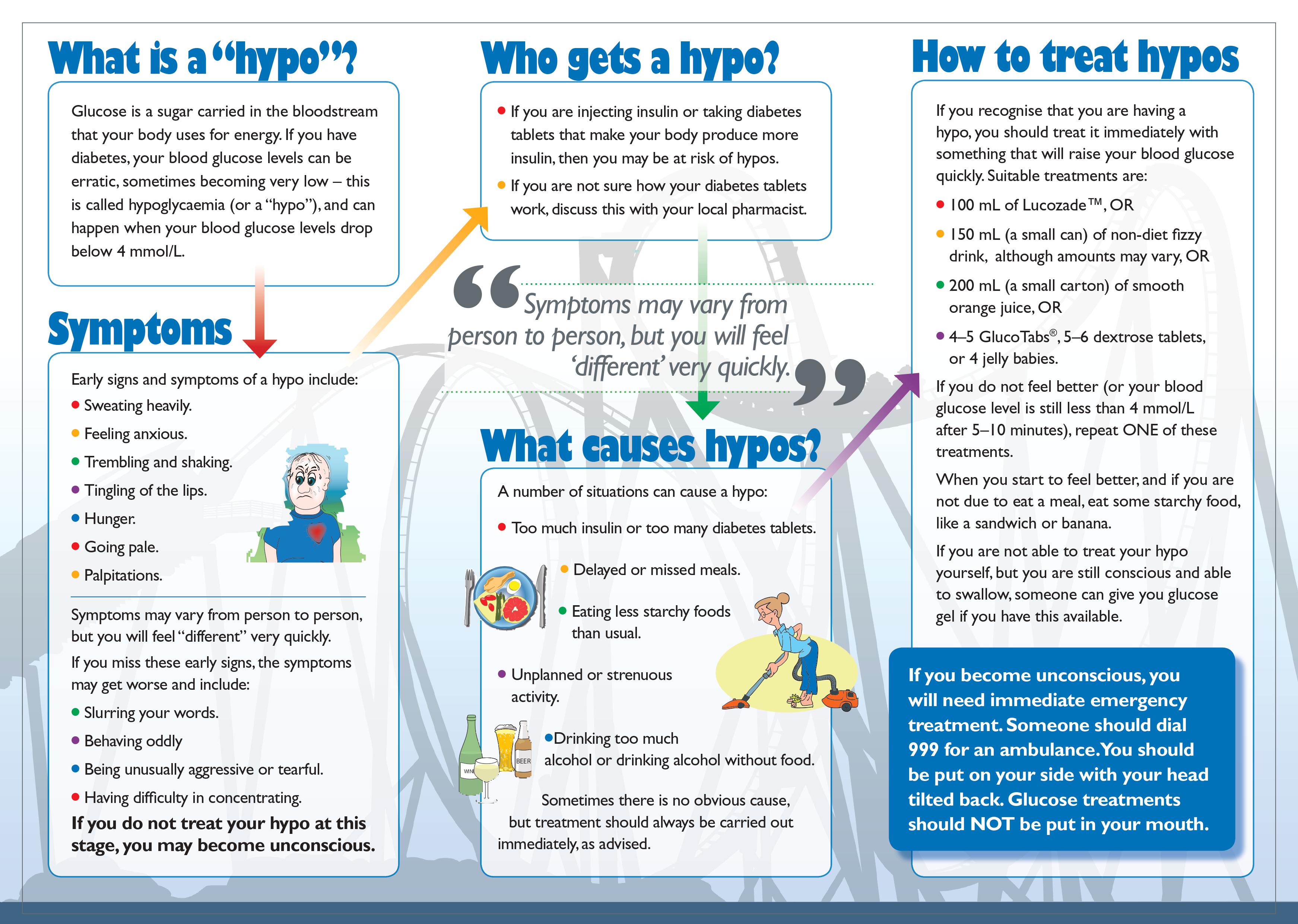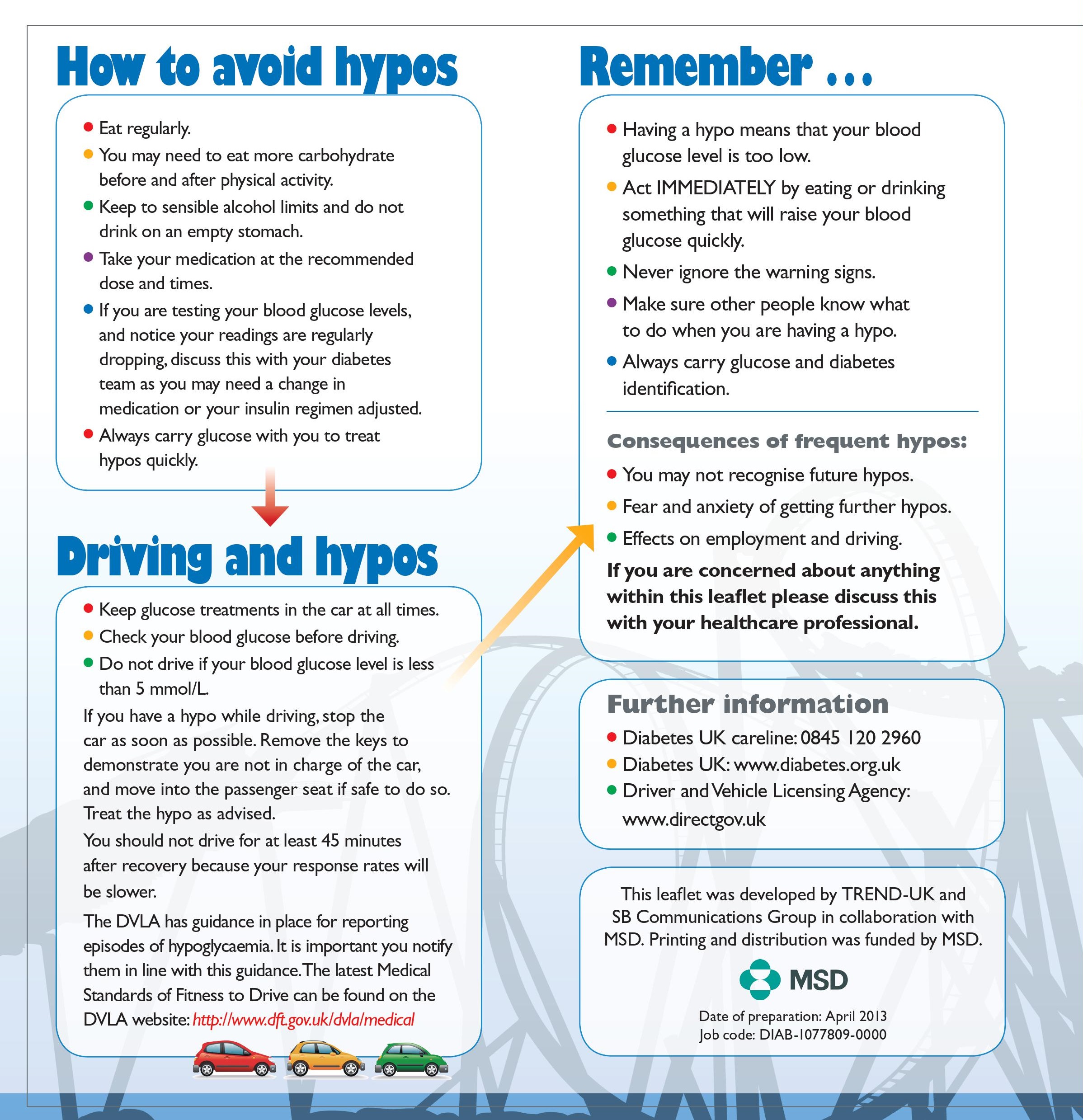
Text from above image:
Why do I sometimes feel shaky, dizzy and sweaty?
What is a "hypo"?
Who gets hypo?
How do I treat my hypo?
How do I avoid a hypo?
What else do I need to know?

Text from above image:
What is a hypo
Glucose is a sugar carried in the bloodstream that your body uses for energy. If you have diabetes, your blood glucose levels can be erratic, sometimes becoming very low - this is called hypoglycaemia ( or a "hypo"), and can happen when your blood glucose levels drop below 4 mmol/L.
Symptoms
Early signs and symptoms of a hypo include:
Sweating heavily.
Feeling anxious.
Trembling and shaking.
Tingling of the lips.
Hunger.
Going pale.
Palpitations.
Symptoms may vary from person to person, but you will feel "different" very quickly.
If you miss these early signs, the symptoms may get worse and include:
Slurring your words.
Behaving oddly
Being unusually aggressive or tearful.
Having difficulty in concentrating.
If you do not treat your hypo at this stage, you may become unconscious.
Who gets a hypo?
If you are injecting insulin or taking diabetes tablets that make your body produce more insulin, then you may be at risk of hypos.
If you are not sure how your diabetes tablets work, discuss this with your local pharmacist.
''Symptoms may vary from person to person, but you will feel 'different' very quickly."
What causes hypos?
A number of situations can cause a hypo:
Too much insulin or too many diabetes tablets.
Delayed or missed meals.
Eating less starchy foods than usual.
Unplanned or strenuous activity.
Drinking too much alcohol or drinking alcohol without food.
Sometimes there is no obvious cause, but treatment should always be carried out immediately, as advised.
How to treat hypos
If you recognise that you are having a hypo, you should treat it immediately with something that will raise your blood glucose quickly. Suitable treatments are:
100 ml of lucozade TM, OR
150 ml (a small can) of non-diet fizzy drink, although amounts may vary, OR
200 ml (a small carton) of smooth orange juice, OR
4-5 GlucoTabs®, 5--6 dextrose tablets, or 4 jelly babies.
If you do not feel better (or your blood glucose level is still less than 4 mmol/l after 5-10 minutes), repeat ONE of these treatments.
When you start to feel better, and if you are not due to eat a meal, eat some starchy food, like a sandwich or banana.
If you are not able to treat your hypo yourself, but you are still conscious and able to swallow, someone can give you glucose gel if you have this available.

Text from above image:
How to avoid hypos
Eat regularly.
You may need to eat more carbohydrate before and after physical activity.
Keep to sensible alcohol limits and do not drink on an empty stomach.
Take your medication at the recommended dose and times.
If you are testing your blood glucose levels, and notice your readings are regularly dropping, discuss this with your diabetes team as you may need a change in medication or your insulin regimen adjusted.
Always carry glucose with you to treat hypos quickly.
Driving and hypos
Keep glucose treatments in the car at all times.
Check your blood glucose before driving.
Do not drive if your blood glucose level is less than 5 mmol/L.
If you have a hypo while driving, stop the car as soon as possible. Remove the keys to demonstrate you are not in charge of the car, and move into the passenger seat if safe to do so.
Treat the hypo as advised.
You should not drive for at least 45 minutes after recovery because your response rates will be slower.
The DVLA has guidance in place for reporting episodes of hypoglycaemia. It is important you notify them in line with this guidance.The latest Medical Standards of Fitness to Drive can be found on the DVLA website: http://www.dft.gov.uk/dvla/medical
Remember ...
Having a hypo means that your blood glucose level is too low.
Act IMMEDIATELY by eating or drinking something that will raise your blood glucose quickly.
Never ignore the warning signs.
Make sure other people know what to do when you are having a hypo.
Always carry glucose and diabetes identification.
Consequences of frequent hypos:
You may not recognise future hypos.
Fear and anxiety of getting further hypos.
Effects on employment and driving.
If you are concerned about anything within this leaflet please discuss this with your healthcare professional.
Further information
Diabetes UK careline: 0845 120 2960
Diabetes UK: www.diabetes.org.uk
Driver and Vehicle Licensing Agency: www.directgov.uk
This leaflet was developed by TREND-UK and SB Communications Group in collaboration with MSD. Printing and distribution was funded by MSD.